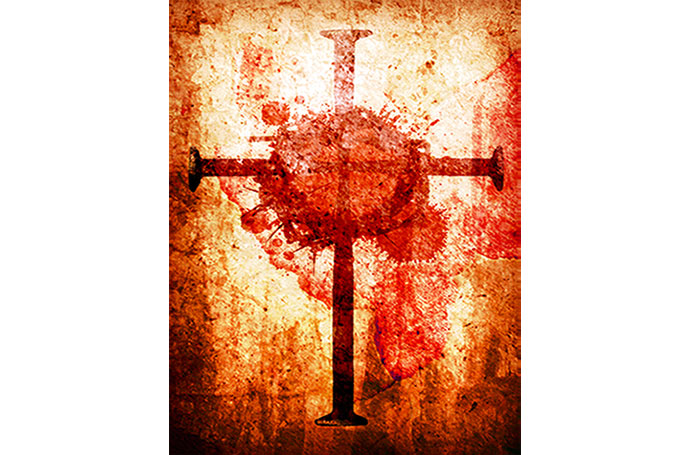“Christ, our paschal lamb, has been sacrificed. Let us, therefore, celebrate the festival, not with the old leaven, the leaven of malice and evil, but with the unleavened bread of sincerity and truth.”
1 Corinthians 5:7-8
The Feast of Passover
The death of Christ, according to the Gospels, occurred at the time of the Passover or Paschal celebration. As Paul put it, Christ is “our Passover,” probably in the sense of “our Passover sacrifice,” or, as the RSV translates it, “our paschal lamb.” The death of Christ on the cross fulfilled all the sacrifices of the old covenant. It was, however, especially a fulfilment of the Passover sacrifice, and therefore the meaning of the Passover shows us the meaning of the death and resurrection of Christ and in consequence the meaning of the Eucharist.1
The Feast of Passover, which was normally understood to include the Feast of Unleavened Bread, was one of the great pilgrim feasts of Israel. It was held in the first month, the beginning of the year. Like all three of the pilgrim feasts, it was a harvest feast, a time for offering first fruits and of rejoicing in God’s blessing. On the second day of Unleavened Bread the first sheaf of new grain was offered, signaling the beginning of the grain harvest. Passover, then, celebrated the blessings of creation which God gave to his people so that they might live.
Like all three of the pilgrim feasts, however, Passover was also a commemoration of what God had done to redeem his people. Pentecost, as we have seen, was the feast that celebrated the giving of the Law at Sinai. Passover celebrated the Exodus from Egypt, the beginning of the events that Jed to Pentecost.
The night before the Exodus was a special night, the night of the last of the ten plagues. Pharaoh had resisted God’s demand, presented through Moses, to let the people of lsrael leave. His resistance led to a contest of strength between himself and God. Each plague was another round in a kind of wrestling match. The last was the plague of the firstborn, because God took the life of the firstborn of all those who dwelled in the land of Egypt to force Pharaoh to comply.
The Passover sacrifice
The Israelites also lived in the land of Egypt and so they too could have lost their firstborn. But God gave them a means of deliverance. Each family was to take a lamb and sacrifice it. The blood of the sacrifice was to be put around the door. When the destroying angel passed through the land of Egypt, he would pass over and not enter into the houses of those who had the blood of the sacrifice on their doors. The sacrificial blood would forbid him entrance and mark the family as belonging to God and so under his protection.
The Passover sacrifice, then, was the sacrifice of deliverance. It was the means by which the Israelites were spared and the Egyptians were defeated. It made possible the Exodus, because it allowed the Israelites to escape, and to escape intact, from Egypt. The Passover feast celebrated that deliverance, and the sacrifices given at that feast were a thanksgiving for it.
Jewish teachers, however, saw more in the Passover celebration than simply the commemoration of the Exodus. One teacher summarized the celebration by saying that there were four events commemorated at the Feast of Passover:2 the night of creation, when God delivered the world from darkness, the night of the “sacrifice” of Isaac, which “sealed” the covenant with Abraham;3 the night of the Passover itself; and the night of the future corning of the Messiah. The three events, commemorated along with the Passover, give a fuller perspective on the meaning of both the Exodus and the Passover sacrifice that made it possible.
First, the Passover gave effect to the covenant that God had made with Abraham. Just as a lamb replaced Isaac in the covenant sacrifice of Abraham, the Passover lamb delivered the people of lsrael from death and made the definitive establishment of the old covenant possible. It effectively enabled the people of Israel, the descendants of Abraham, to become God’s people. It opened the way for them to be brought by God to Sinai and there given the same covenant that was given to Abraham, but in a new way, as a people and with instruction on how to live as a people.
The Feast of Passover also involved a commemoration of the creation, possibly originally because this feast occurred in the “first of months” and was the feast to celebrate the beginning of the yearly harvest. But since the Passover celebrated the event that established the people of lsrael, the participants were also celebrating an event that began the restoration of the world. As a result of the Passover sacrifice, the people of Israel were enabled to be the start of the new creation, the first of those who would be redeemed to belong to God from among all the nations of the earth.
Even in Jewish understanding the effect of the Passover sacrifice went beyond the people of Israel, because it would ultimately bring about the fulfilment of the promise to Abraham that in him all nations would be blessed (Genesis 12:1-3; Galatians 3:8). When the prophesied Messiah, the anointed King of Israel, would come, he would establish the rule of God over the nations of the earth, and then they would experience God’s blessing as well. For this reason, the Passover looked forward to the coming of the Messiah, and most Jews at the time of Jesus expected the Messiah to come during the “night of watching” (Exodus 12:42) at Passover time. The Passover, in short, celebrated God’s creation of the world and of his people and looked forward to his completion of that work when the Messiah would come.
Coming of the Messiah during Passover
Over a millennium after the Exodus, the Passover season brought together the people of lsrael in the year A.D. 33 (or possibly A.D. 30), at a time when they were ruled by the Romans. They hoped for deliverance again, this time from their Roman overlords. Many were expecting a Messiah who would proclaim an uprising and deliver them, and they were expecting him to come at this or a Passover in the near future.
The Messiah did come in the person of our Lord Jesus Christ. Most of the Jewish people did not receive him as the Messiah, in part because of how he came. He did not come as a conquering king but as a Passover lamb. He would begin a redemption that would be completed only when he came conquering from heaven to judge the living and the dead.
As we have seen, Jesus came to offer the sacrifice that would make a true deliverance possible, the deliverance from sin. He came to defeat the powers of darkness, so that when God judged evil, his people would be spared. He came to shed the blood that could be put on his people so that they could be recognized as God’s, protected from the destroying angel. He came, in the words of the prophet Zechariah (Zechariah 13:1), so there would be “a fountain opened for the house of David and the inhabitants of Jerusalem to cleanse them from sin and uncleanness” so that they would be ready to serve the kingdom of God.
He was betrayed during Passover week, given over to be killed as the Passover lambs were. On the night of his betrayal he ate a supper with his disciples. There is some dispute as to whether he ate the Passover meal with them or ate some anticipation of the Passover meal.4 But his farewell meal occurred as the first step in offering his life at Passover season tor the deliverance of his people.
The New Covenant Passover sacrifice of Christ
The sacrifice of Christ did not just free people from their sins. It also established the covenant of God with his people on a new basis, a basis that made it fully open to those who were not Israelites and would bring them God’s kingdom and blessing. Involved in this was the outpouring of the Holy Spirit, who would make believers into new human beings and join them to the Church, the beginning of the new human race. In offering the sacrifice of himself, Christ completed the work of beginning the new creation, the work that would ultimately bring God’s creation to the purpose for which it had been intended. When we celebrate the death and resurrection of Christ, the fulfilment of Passover, then we are celebrating the event by which the purpose of God’s creation, the reason for which God made the human race, will be accomplished.
Meditation: The New Covenant
Exodus 24:4-11
In the twenty-fourth chapter of the Book of Exodus, we can read about the conclusion of God’s manifestation to the people of Israel on Mount Sinai. They had come before him at the foot of the mountain, he had appeared before them in his glory, and he had spoken to them. He had given them the Ten Commandments and so made a covenant with them. They had agreed to accept the covenant and live by it.
Between the giving of the Ten Commandments and the events in chapter 24 is an extensive body of instruction now called the Covenant Code. Some commentators have understood this to have been given with the Ten Commandments. Some have understood it to have been given later and inserted here in the text. Either way, it is associated with the Ten Commandments and shows how the Ten Commandments are to be lived out by old covenant people. Then occurs the following passage in chapter 24,
“And Moses wrote all the words of the Lord. And he rose early in the morning, and built an altar at the foot of the mountain, and twelve pillars, according to the twelve tribes of Israel. And he sent young men of the people of Israel, who offered burnt offerings and sacrificed peace offerings of oxen to the Lord. And Moses took half of the blood and put it in basins, and half of the blood he threw against the altar. Then he took the book of the covenant, and read it in the hearing of the people; and they said, ‘All that the Lord has spoken we will do, and we will be obedient.’ And Moses took the blood and threw it upon the people, and said, ‘Behold the blood of the covenant which the Lord has made with you in accordance with all these words.’”
The description above is of a sacrifice that is not strictly paralleled anywhere else in the worship of the old covenant. First, a group of young men offers the sacrifices, not the priests and Levites. That is an indication that we are reading about a sacrificial ceremony that occurs before the temple worship is established.
The offering consists of burnt offerings and peace offerings. Moses takes the blood of the offering, the way a priest would in a temple ceremony, and throws half the blood on the altar as a way of giving it to God. He then reads the “book of the covenant,” and the people again commit themselves to be obedient and keep the covenant. He then throws the blood on the people. When he does so he says, “This is the blood of the covenant which the Lord has made with you, in accordance with all these words.” In other words, this blood establishes a covenant relationship with God, your part of which is keeping the commandments stated in this book. This too is a special event that was not repeated in temple worship.
Moses, in short, sealed the covenant with sacrificial blood, as many other covenants at that time were sealed. The concluding sacrifices were part of the process of making the covenant and so a means of reconciling the two parties and uniting them together. The agreement in word was not enough for something as solemn as a covenant that would establish a lifelong relationship, but needed to be sealed by the sacrifice. In this case the relationship was not simply a friendship relationship between two human partners but between the people of lsrael and God.
“The blood of the covenant” are the words Jesus used as narrated in the Gospel of Mark and then, in a slightly different phrasing, in 1 Corinthians, to describe the cup of wine that was drunk at the Eucharist. The Letter to the Hebrews refers to the same event in a similar way in chapter 9 (vv. 18-19). The phrase “blood of the covenant” tells us that not only was the death of Christ a fulfilment of the Passover sacrifice, which redeemed the people of Israel, it was also a covenant-sealing sacrifice.
The throwing of the blood by Moses was a sign of the joining of God and the people of Israel in a covenant relationship. Partaking of the Eucharist, then, is renewing the covenant relationship with God. Such a thing can, however, only be sealed, that is, fully accomplished, because of a sacrifice. In this case the sacrifice is the sacrifice of Christ, whose blood is given to us to drink, apparently as an equivalent of what happened when the blood was thrown on the old covenant people at Sinai.
The account in the chapter then continues.
“Then Moses and Aaron, Nadab, and Abihu, and seventy of the elders of Israel went up, and they saw the God of lsrael; and there was under his feet, as it were, a pavement of sapphire stone, like the very heaven for clearness. And he did not lay his hand on the chief men of the people of Israel; they beheld God, and ate and drank.”
In other words, the elders, the representatives of the people, took a meal with God. This meal is probably the sacrificial meal that is associated with making a covenant (see Genesis 26:30), a meal in which the two parties ate the peace offering. In so doing, they were like priests who were eating a sacred meal in the temple, in the place of God’s presence. The conclusion of the covenant on Sinai and the sacrifice that sealed it was a meal that expressed the family bond between God and his people. During this meal, in some sense, the elders beheld God.
The Eucharist is such a meal, even though we do not partake of much food and drink. It is a meal in which the covenant relationship with God is renewed. As the body of the sacrificial victim was eaten and the blood was put on the worshipers in Exodus 24, so in the Eucharist the Body of Christ is eaten and his Blood drunk. In this meal, the relationship with God is renewed through partaking of the Body and Blood of the Lord, offered on the cross to establish the covenant. As a result, we are renewed in our personal knowledge of God (Jeremiah 31:34; Hebrews 8:11; 12:22-24).
The Eucharist is not, however, a meal to renew the old covenant. The blood is the blood of the new covenant. It is the new covenant which is established by the death and resurrection of Christ and which is renewed in the Eucharist. It is this new covenant relationship that will be consummated at the end of time when, in heaven itself, we take part in the festal meal of the marriage feast of the Lamb, celebrating his union with his people. Then those who come from east and west, from the rising of the sun to its setting, will “sit at table with Abraham, Isaac, and Jacob in the kingdom of heaven” (Matthew 8:11) and will see God “face to face” (1 Corinthians 13:12).
What happened at the top of Mount Sinai foreshadowed the meal that we partake of in the Eucharist. That, in turn, will strengthen our covenant relationship with God “until [Jesus) comes” to take his people to the great feast in the kingdom of God (1 Corinthians 11:26). Then, God will be “everything to everyone” (1 Corinthians 15:28).
This article by Steve Clark is excerpted from his book, Catholics and the Eucharist: A Scriptural Interpretation, Chapter Four, © 2000 by Stephen B. Clark, published by Charis Books, an Imprint of Servant Publications, Ann Arbor, Michigan, USA.
See related articles from Redeemer: Understanding the Meaning of the Life, Death, and Resurrection of Jesus Christ, by Steve Clark:
• The Redeemer – What God Wanted
• The Great Downfall
• The Redeemer Who Died
• The Obedient Son: The humility of the Son of the King
• Christ’s Humility and Victory
• Dying to Defeat Death: The death of Jesus was a victory over death itself
• Exalted Over All: The Victory of the Redeemer
• New Life in Christ
• Receiving Redemption: United with Christ we pass from death to new life
Top image credit: Graphic artwork depicting the blood-stained cross of Christ, from rgbstock.com, © by ba1969 (Billy Frank Alexander). Used with permission.
Steve Clark has been a founding leader, author, and teacher for the Catholic charismatic renewal since its inception in 1967. Steve is past president of the Sword of the Spirit, an international ecumenical association of charismatic covenant communities worldwide. He is the founder of the Servants of the Word, an ecumenical international missionary brotherhood of men living single for the Lord.
Steve Clark has authored a number of books, including Baptized in the Spirit and Spiritual Gifts, Finding New Life in the Spirit, Growing in Faith, and Knowing God’s Will, Building Christian Communities, Man and Woman in Christ, The Old Testament in Light of the New.
- See articles by Steve Clark in Living Bulwark Archives



